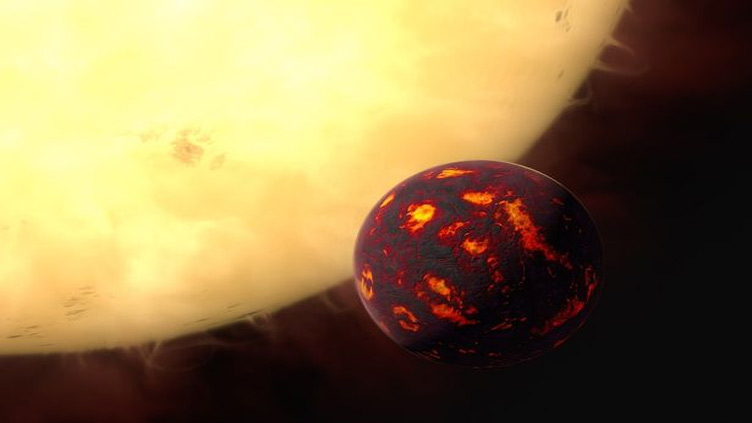An entire year lasts only 18 hours on the Incredible 'hell planet'

WeirdNews
The temperatures during the day average is around 2573 Kelvin
NEW YORK (Web Desk) - New research has shown on the scorching hot hell planet that is circulating a distant star and bares a giant lava ocean, making it far too toasty for human life.
Scientists have released new research on the hell planet and how the scorching hot super-Earth became an orbiting ball of lava.
The rocky world, known as 55 Cancri e or its nickname Janssen , orbits its star so closely that a year lasts just 18 hours and has a surface that resembles a deep lava ocean.
It is thought that temperatures during the day average around 2573 Kelvin - or a whopping 2,300C.
The information has been released thanks to a new tool that captured ultra-precise measurements of the starlight shining from Janssen’s sun, known as Copernicus or 55 Cnc.
In the new orbital analysis published in the journal Nature Astronomy, it was revealed that the planet orbits Copernicus 70 times closer than Earth orbits the Sun.
While the planet was always hot, it may have only gained its hellish conditions due to being drawn into its star s equator following shifts in the gravity felt from Copernicus, the red dwarf and Janssen s sister planets.
Lily Zhao, an astrophysicist who led the study, said: “We’ve learned about how this multi-planet system — one of the systems with the most planets that we’ve found — got into its current state."
The researcher added that even in its original orbit, the planet “was likely so hot that nothing we’re aware of would be able to survive on the surface".
Live Science reports that the team of scientists wanted to study the distant system to assess how the planets have evolved over time and how it is different from our solar system where all planets occupy mostly identical orbital planes.
Upon its discovery and confirmation, Janssen became the first known example of an ultra-short-period planet with its 18-hour year length.
Its orbit has a minimum radius of roughly two million kilometers, whereas the Earth has a minimum radius of about 147 million.
This discovery is exciting for scientists, Zhao explained, as it could help researchers identify hospitable planets in the future - and help them understand the likelihood that a welcoming planet could turn into a lava-covered hellscape.
"Understanding how planets evolve and migrate will definitely impact our understanding of planetary habitability likelihoods," Zhao said in an email to Motherboard.
"The habitable zone is a good rule of thumb for whether a planet could sustain water-based life at present, but in order for life to successfully form, a planet must stay habitable for the time it takes life to manifest.
"It is therefore essential to understand how planets might move around in systems with different numbers and types of planets as well as around different stars to understand how long a planet has been and/or will stay habitable."
The team of researchers are now using specialist equipment called EXtreme PREcision Spectrometer (EXPRES) at the Lowell Observatory’s Lowell Discovery Telescope in Arizona, hoping to better understand how exoplanets move from their original positions and change as they do.
The group will also investigate what the planet is made of, with many guesses hinting that its core could be made up of diamonds.
"Diamond is one possible explanation for the size and mass of 55 Cancri e, but we really can t be sure what this planet is made of,” Zhao said. “In fact, the composition of smaller, low-mass planets like 55 Cancri e is not currently well understood because it has been difficult to measure the mass of these planets.
“With the potential for more precise [radial velocity] measurements using EXPRES, we will be able to discover and determine masses for more of these planets and get a better grasp of what these planets might be made of,” she added.

